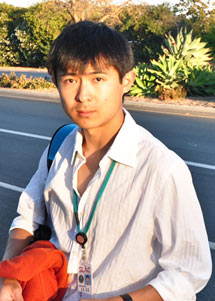
Handy Links
SLAC News Center
SLAC Today
- Subscribe
- Archives: Feb 2006-May 20, 2011
- Archives: May 23, 2011 and later
- Submit Feedback or Story Ideas
- About SLAC Today
SLAC News
Lab News
- Interactions
- Lightsources.org
- ILC NewsLine
- Int'l Science Grid This Week
- Fermilab Today
- Berkeley Lab News
- @brookhaven TODAY
- DOE Pulse
- CERN Courier
- DESY inForm
- US / LHC
SLAC Links
- Emergency
- Safety
- Policy Repository
- Site Entry Form

- Site Maps
- M & O Review
- Computing Status & Calendar
- SLAC Colloquium
- SLACspeak
- SLACspace
- SLAC Logo
- Café Menu
- Flea Market
- Web E-mail
- Marguerite Shuttle
- Discount Commuter Passes
-
Award Reporting Form
- SPIRES
- SciDoc
- Activity Groups
- Library
Stanford
Around the Bay
Zhu to Receive Klein Award

(Photo courtesy Diling Zhu.)
Stanford applied physics graduate student Diling Zhu has been chosen as the recipient of the 2010 Melvin P. Klein Scientific Development Award for his work at SLAC's Stanford Synchrotron Radiation Lightsource. Zhu, who completed his Ph.D. research in the Stöhr group, will accept the award October 18 at the joint SSRL-Linac Coherent Lightsource Users' Meeting.
The Klein award has been given annually since 2006 to undergraduates, graduate students and postdocs for outstanding research conducted at SSRL. The award comes with a $1,000 prize to help the recipient disseminate his or her scientific results.
"This was actually quite a surprise—a very good surprise," Zhu said. "I will do my best to give a good talk at the Users' Meeting."
Using SSRL Beamlines 5-2 and 13-3, Zhu worked to develop a new experimental technique to carry out a process called X-ray holography. Whereas regular cameras record photons as they travel like particles, holography makes use of the wave-like properties of light. To do this, researchers illuminate a sample with a beam of coherent X-rays. Some of these X-rays are scattered by the object to be studied, while another portion are scattered by a reference structure. Much as the collision of two small water waves creates new ripple patterns, these two beams of light interact, forming interference patterns. Researchers then collect the scattered X-rays in a detector and typically employ computer algorithms to reconstruct the sample's two-dimensional image. Yet these algorithms require significant computing power and it is difficult to know whether something went wrong.
In his thesis, Zhu describes two new methods to more accurately and reliably reconstruct the two-dimensional image of the object from the interference pattern. One of these methods creates two different patterns, slightly increasing the complexity of the experiment but making the reconstruction process much quicker and allowing researchers to confirm their reconstructions. The second overcomes a common problem: detectors cannot record the part of the interference pattern in the path where the light beam travels, because the bright light would overwhelm the detector.
"With iterative algorithms, this missing chunk of data makes it very difficult to reconstruct your sample," Zhu said. But with the new method, which uses sharp features in a reference structure, such as the corners in a triangle, introduced next to the actual sample to create a second, reference light beam, reconstruction is possible even with this missing data. The method also offers a higher-resolution reconstruction, offering more detail about the sample's structure.
"The importance of Diling's work is increased reliability in obtaining real space images from the obscure X-ray scattering patterns," said Jo Stöhr, director of the Linac Coherent Light Source and Zhu's thesis advisor. "We now have two robust methods which give us robust and reliable pictures of nanostructures. These methods will be used at both SSRL and LCLS and at other X-ray facilities around the world."
Zhu, who turned in his doctoral thesis last month, now works as a post-doctoral researcher on the X-ray Pump-Probe instrument at the LCLS. A paper on this work was recently published in Physical Review Letters.
—Kelen Tuttle
SLAC Today, September 13, 2010